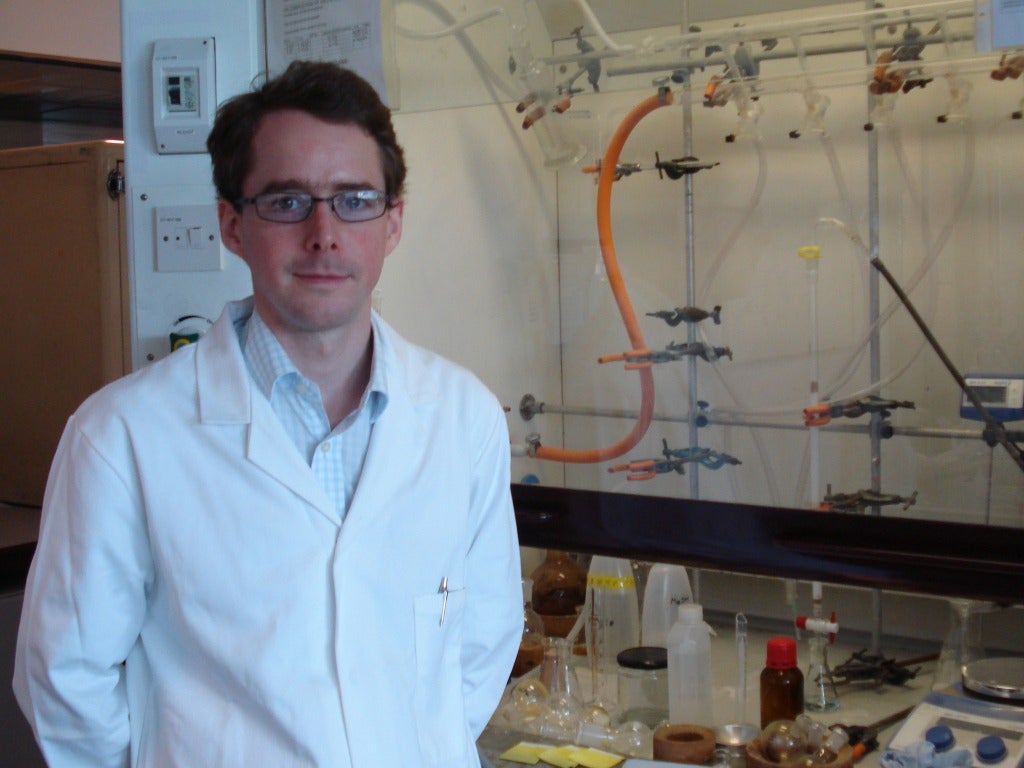What's it like to study... Chemistry
Kingston University Master of Chemistry graduate Edmund Burke shares his experiences of studying for his degree and explains why his passion for the subject has led on to a PhD

After finishing school I went directly to university. The first couple of weeks were horrible, though, and I left.
Seven years later I tried again. I attended several open days at Kingston University in London, which had been recommended to me by a cousin. The friendly approachable nature of the academic staff I met there convinced me to give the whole university experience another go. So with no small trepidation I embarked on a MChem course, which took four years, finishing with a masters.
Fortunately, given I had done my A-levels some seven years previously, I found the open days had given me a very realistic impression of the academics. That made my first semester less of an uphill struggle than it might have been while I tried to remember the stuff I had forgotten and also learned the new material.
Right from the outset it was apparent that the course was well structured with material covered in one module complementing that covered in other modules. In the first year, not only did we cover the core areas of general chemistry, including organic, physical, and inorganic chemistry, we also did environmental, and pharmaceutical chemistry.
Modules such as these gave a new dimension to chemistry, clearly elucidating the importance of chemistry both socially and economically and stimulated discussion between the students as to possible careers – as diverse as environmental monitoring of pollutants to more obvious jobs working in pharmaceutical companies.
As the course progressed, the multi-layered and integrated nature continued. In addition to the lectures on organic, physical, inorganic, and analytical chemistry, we also covered modules on biomaterials, which encompassed the metals, plastics, gels and ceramics used in a whole series of healthcare roles, including joint replacements, contact lenses, false teeth, artificial limbs and glucose monitors used by diabetics.
Modern materials, meanwhile, looked at plastics, metals, and others used in a whole host of applications from helicopter rota blades, parachutes, golf clubs, computer chips, flat panel displays and OLED technology. The course also included a range of medicinal chemistry modules, including computer-aided drug design, medicinal chemistry and, of course, drugs from natural sources.
By their very nature, degrees in the physical sciences are like a massive problem-solving exercise, where whatever you have just learned needs to be applied to solve a problem. The workshops, practicals and assignments all extended this, requiring us to look endlessly at things from a different perspective. On top of this, there were numerous group assignments requiring a highly co-ordinated effort to achieve good results.
In my fourth year I undertook a project with one of my professors, Peter Foot, working in the area of electro-luminescent polymers and novel ways of increasing the quantum yield. Put simply, we were trying to make plastic-like substances that glow when an electric current is passed through them and to increase the efficiency so that they would give out more light.
At this time I was also looking for a PhD position to continue my studies. I settled on the area of organic chemistry and got a position supervised by Professor Jonathan Clayden at the University of Manchester, where I now work on the sustainable, semi-synthetic production of sanguinine. No one except other chemists ever seems to have a clue what that means! Within plants – and other living things – there are whole networks of biological pathways, like little production lines all making different things. When a plant is harvested, the production lines halt and only a small amount of the desired compound (drug molecule) will be present. This means that it is often prohibitively expensive to produce medicines in this fashion, but in some instances it is the only feasible way. Once the drug is extracted from the harvested plants we can then look for components from other parts of the production line and then develop methods for synthetically completing the production line. Hence the term 'semi'-synthesis – the plant did the hard bit and we 'just' finish it off.
The concept is used to produce a number of very important drugs such as taxol from yew trees, which is used to treat some refractory cancers, and some other drugs also used to treat cancer. My specific project looks at the semi-synthesis of sanguinine and the closely-related galanthamine. The latter is used to treat Alzheimer’s disease and can be extracted from snowdrops and daffodils. Looking for the other useful components in the daffodil juice is like a massively complex sudoku puzzle. We also look at new methods for the structural modification of these compounds to see if we can increase their effectiveness.
Overall I think chemistry is an amazing subject. Chemistry is all around us, from cleaning products and dyes to lights, gadgets, medicines and forensics. The list is endless, as are the varied job possibilities. You will not end up working in Boots - they are pharmacists, not chemists - but you could end up working almost anywhere else. A degree in chemistry hones your problem-solving skills and teaches you patience and persistence.
Subscribe to Independent Premium to bookmark this article
Want to bookmark your favourite articles and stories to read or reference later? Start your Independent Premium subscription today.

Join our commenting forum
Join thought-provoking conversations, follow other Independent readers and see their replies